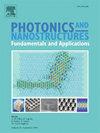Inverse design of incommensurate one-dimensional porous silicon photonic crystals using 2D-convolutional mixture density neural networks
Abstract
This work proposes an inverse design tool for porous silicon photonic structures. This tool is based on 2D-convolutional mixture density neural networks given that this type of architecture allows to tackle the nonuniqueness problem present in the optical response of photonic crystals. Moreover, a preprocessing reshaping method was implemented to use 2D-convolution neural networks due to their powerful ability in pattern recognition. A data set of porous silicon photonic spectra was generated. The photonic structures consist of 12 assembled layers of different thicknesses and porosities, generating incommensurate one-dimensional photonic crystals. The model was tested with four test data sets. First, a periodic validation was carried out, showing that incommensurate structures can generate well-defined photonic bandgaps. The second test set found that incommensurate photonic structures can resemble the optical response of a modulated photonic crystal and retrieve defective modes within the bandgap. The third test data set consisted of ideal distributed Bragg reflectors. It was found that the neural network could not predict accurate design due to the notorious differences in the optical properties of the two structures. Last, the neural network was tested with the experimental spectrum of a porous silicon photonic crystal, and it was shown that the predictions made were inaccurate because the simulations did not consider critical experimental aspects.

 求助内容:
求助内容: 应助结果提醒方式:
应助结果提醒方式:


